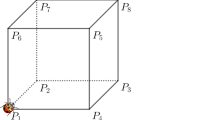Abstract
In this paper, we describe the design and implementation of computer programming activities aimed at introducing young students (9–13 years old) to the idea of infinity, and in particular, to the cardinality of infinite sets. This research was part of the WebLabs project where students from several European countries explored topics in mathematics and science by building computational models and programs, which they shared and discussed. We focus on a subset of the work in which students explored concepts of cardinality of infinite sets by interpreting and constructing computer programs in ToonTalk, a programming language and environment that is especially well-suited for young students. Our hypothesis is that via carefully designed computational explorations within an appropriately constructed medium, infinity can be approached in a learnable way that does not sacrifice the rigour necessary for mathematical understanding of the concept, and at the same time contributes to introducing the real spirit of mathematics to the school classroom.










Similar content being viewed by others
Notes
This contrasts sharply with the typical maximum integer size of 231 (ten decimal digits), which are those that fit in 32 bits (with one bit used for specifying the sign).
After analysing the data we noticed the ambiguity of the word “countable” caused confusion. A revised version of the activity materials should be revised to avoid this.
References
Dauben, J. W. (1990) Georg cantor: His mathematics and philosophy of the infinite. Princeton University Press: Princeton, NJ.
diSessa, A. (2000). Changing minds. Computers, learning and literacy. Cambridge, MA: MIT Press.
Falk, R., & Ben-Lavy, S. (1989) ‘How big is an infinite set? Exploration of children’s ideas’. In Proceedings of the Thirteenth Annual Conference of the International Group for the Psychology of Mathematics Education, Vol. 1, pp. 252–259.
Fischbein, E., Tirosh, D., & Hess, P. (1979). The intuition of infinity. Educational Studies in Mathematics, 10, 3–40.
Hilton, P. (1991). The mathematical component of a good education. Miscellanea Mathematica. Berlin: Springer.
Kahn, K. (2001) ‘Generalizing by Removing Detail’, Communications of the ACM, 43(3), March 2000. An extended version is in Henry Lieberman, editor, Your Wish Is My Command: Programming by Example, Morgan Kaufmann, 2001.
Kaput, J., Noss, R., & Hoyles, C. (2002) Developing New Notations for a Learnable Mathematics in the Computational Era. In English, L. (Ed.), Handbook of international research in mathematics education, (pp. 51–75). London: Lawrence Erlbaum (Reprinted in Second Edition, 2008).
Lang, S. (1985). Math!: encounters with high school students. New York Inc: Springer.
Maor, E. (1987). To infinity and beyond: A cultural history of the infinite. Boston: Birkhäuser.
Monaghan, J. (2001). Young peoples’ ideas of infinity. Educational Studies in Mathematics, 48, 239–257.
Mor, Y., & Sendova, E. (2003). ToonTalking about mathematics. In I. Derzhanski, H. Dimitrova, S. Grozdev, E. Sendova (Eds.), History and education in mathematics and informatics, attracting talent to science, (pp. 36–43) Proceedings of the International Congress MASSEE 2003, September 15–21. Borovets, Bulgaria.
Noss, R. & Hoyles, C. (1996) Windows on mathematical meanings. Learning cultures and computers. Kluwer Academic Publishers: Dordrecht, Boston, London.
Papert, S. (1972). Teaching children to be mathematicians versus teaching about mathematics. International Journal of Mathematics Education and Science and Technology, 3, 249–262.
Piaget, J., & Garcia, R. (1989). Psychogenesis and the history of science. Columbia University Press: New York.
Sacristán, A. I. (1997). Windows on the infinite: Constructing Meanings in a Logo-based Microworld. PhD. Dissertation, Institute of Education, University of London, UK.
Sacristán, A. I., & Noss, R. (2008). Computational construction as a means to coordinate representations of infinity. International Journal of Computers for Mathematical Learning, 13(1), 47–70.
Simon, M. A., & Tzur, R. (2004). Explicating the role of mathematical tasks in conceptual learning: An elaboration of the hypothetical learning trajectory. In Mathematical Thinking and Learning, 6(2), 91–104.
Tall, D. O. (2001). A child thinking about infinity. In Journal of Mathematical Behavior, 20, 7–19.
Tsamir, P. (2001). When ‘The Same’ is not perceived as such: The case of infinite sets. Educational Studies in Mathematics, 48, 289–307.
Wilensky, U., & Papert, S. (2010). Restructurations: Reformulations of Knowledge Disciplines through new representational forms. In J. Clayson & I. Kallas (Eds.), Proceedings of the constructionism 2010 Conference. Paris, France.
Acknowledgments
The WebLabs project was funded by Grant IST 2001-3220 of the Information Society Technologies Programme of the European Commission. We wish to thank the European Union for funding this project. We are indebted to the Bulgarian institutions which provided excellent conditions for organizing the sessions on infinity: Twenty First Century Academy in Plovdiv, The Institute of Mathematics and Informatics at the Bulgarian Academy of Sciences, The Faculty of Mathematics and Informatics at Sofa University. Our deep gratitude to the Bulgarian coordinator, Dr Iliana Nikolova, and the teachers involved in the WebLabs project (George Gachev—in Sofia, and Liliana Moneva—in Plovdiv). And last, but not least—to the youngest participants in the project, the students, for their infinite creativity. We are very grateful to the UK schools Theydon Bois Primary School and the Cherwell School in Oxford and their students who spent many hours using our software and learning materials to explore infinity.
Author information
Authors and Affiliations
Corresponding author
Rights and permissions
About this article
Cite this article
Kahn, K., Sendova, E., Sacristán, A.I. et al. Young Students Exploring Cardinality by Constructing Infinite Processes. Tech Know Learn 16, 3–34 (2011). https://doi.org/10.1007/s10758-011-9175-0
Published:
Issue Date:
DOI: https://doi.org/10.1007/s10758-011-9175-0




